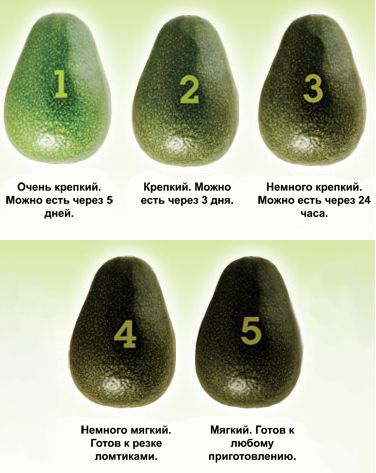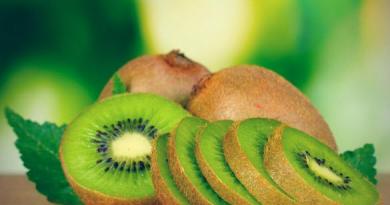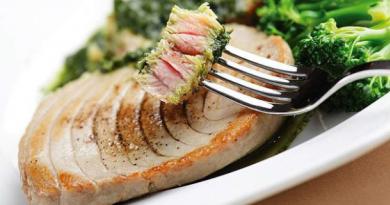Avocado cultivation has been actively expanding since the 1960s - where the warm climate allows. Which countries grow avocados for export? Mexico, several countries of South America, the USA, Spain, Rwanda and Kenya are the main exporters from 100 thousand tons per year.
In Russia and Ukraine, many varieties of avocados can be found on sale. The most common summer ones are Bacon, Fuerte, Reed, fat Pinkerton. Among the winter - Gwen, Hass, Ettinger, Ryan, Ardith, low-fat Pinkerton.
All varieties combine the main advantages of avocados - the richest composition of vitamins and minerals, useful fatty acids and biologically active compounds.
Already know how useful avocado is, and want to immediately learn how to choose the right one?
Click #6 in the table of contents below for tips with illustrations!
Quick article navigation:
Composition and calories
Due to its high nutritional value and diverse composition, avocados can be put in the TOP 5 superfoods for youth and health. Judge for yourself.
Avocado nutritional value and calories per 100 g
For example, we describe the average data for the most common varieties in the United States, which are grown in California and Florida. The average fruit weight ranges from 150 to 250 grams.
Here is what is contained in 100 grams of pulp avocados according to the US National Department of Agriculture, based on a menu of 2000 kcal, where DN is the average daily nutrient requirement:
- Calorie content - 160 kcal - 8% DV
- Carbohydrates - 8.53 g - 3% DV
- Of which dietary fiber - 6.7 g - 27% DV
- Protein - 2 g - 4% DV
- Fat - 14.7 g - 23% DV
- Saturated - 2.1 g
- Monounsaturated - 9.8 g
- Polyunsaturated - 1.8 g
The glycemic index of an avocado is only 10 units. Fruit is allowed to be added to salads even in strict phases of protein diets (Montignac, Kremlin, Atkins, Dukan).
vitamins
Descending:
- Pantothenic acid (B5) - 1.39 mg - 28% DV
- Vitamin K - 21 mcg - 26% DV
- Vitamin B6 - 0.257 mg - 20% DV
- Folic acid (B9) - 81 mcg - 20% DV
- Vitamin E - 2.07 mg - 14% DV
- Niacin (B3) - 1.738 mg - 12% DV
- Vitamin C - 10 mg - 12% DV
- Riboflavin (B2) - 0.13 mg - 11% DV
- Thiamine (B1) - 0.067 mg - 6% DV
- Vitamin A - equivalent to 146 IU - 3% DV
From carotenoids: beta-carotene, lutein, zeaxanthin.
Minerals
Descending:
- Potassium - 485 mg - 10% DV
- Magnesium - 29 mg - 8% DV
- Manganese - 0.142 mg - 7% DV
- Phosphorus - 52 mg - 7% DV
- Zinc - 0.64 mg - 5% DV
- Iron - 0.55 mg - 4% DV
- Calcium - 12 mg - 1% DV
Other components:
- Water - 73.23 g
- Fluorine - 7 mcg
- Beta-sitosterol - 76 mg
*Source: USDA Nutrient Database
Composition and calorie content of 1 pc. avocado varies depending on the weight and fat content of the fruit. For example, the relatively low-fat variety Ettinger, and extremely saturated with Rayan fats.
In America, a popular serving of avocados at one time is half a medium fruit of the widespread Fuerte, Bacon, etc. Portion weight is about 70 grams.
What is contained in such a half?
113 calories, 6 g of carbohydrates, of which only 0.2 g is sugar, and as much as 4.6 per g of dietary fiber, 10 g of fat. And also (in brackets - percentage of DN):
- Vitamin K - 14 mg (19%)
- Vitamin B9 - 60 mg (15%)
- Vitamin C - 6 mg (12%)
- Potassium - 343 mg (10%)
- Vitamin B5 - 2 mg (10%)
- Vitamin B6 - 0.4 mg (9%)
- Vitamin E - 1.3 mg (7%)
- Magnesium - 19.5 mg (6%)
What is useful avocado
The richest composition forms a lot of useful properties of avocados. Get ready for numerous and justified delights.
Monounsaturated fats
The unique difference of avocado is its powerful fat composition. It provides up to 75% of the calorie content of the fetus (!) and relies on monounsaturated fats. Avocado and oil from it are one of the leaders in the content of monounsaturated fats.
Oleic acid predominates - the same beneficial omega-9 that is so attractive in olive oil. Entering the body regularly, it reduces low-density lipoproteins and at the same time increases the level of “good cholesterol” (high-density lipoproteins). There is a normalization of the lipid profile or, in simple words, the use of products with oleic acid reduces the risk of atherosclerosis.
In addition to valuable fats, an exotic fruit is an excellent source of many vitamins and minerals at once.
Vitamins and minerals for health
The richest composition in terms of B vitamins: there is almost everything! Their common primary function is the proper functioning of the nervous system. And the vitamins B6 and B9 present in the fruits are also tireless workers of methylation, which are involved in DNA synthesis. Each of them is at least 1/5 of the daily value in just 100 grams of avocado.
Well-studied properties of folic acid (B9) are the prevention of neural tube defects in the fetus in the first trimester of pregnancy and the reduction of the likelihood of ischemic stroke in people over 50 years of age. There is also vitamin B1 in avocados, it directly affects the reduction of protein glycation, which prolongs our youth.
The composition of antioxidants is also impressive - again a full range of substances in a tangible amount - vitamins A, C, E, zinc and a little selenium. Only in synergistic interaction, these substances provide the body with high-quality protection against oxidative stress. Prevention of oncology and vascular accidents is the main advantage of a diet rich in antioxidants. By including avocados on the menu, you can get all the participants in one serving of fruit.
Another advantage of the unusual fruit is vitamin K, which is important for calcium metabolism, fats, which are needed for the absorption of this vitamin, and a little calcium itself.
So, neuroprotectors, DNA synthesis, antioxidant complex, skeletal quality and cardiovascular activity - an impressive list of benefits in just 100 grams of fatty pulp.
But that's not all the benefits of avocados!
Dietary fiber and plant sterols
A whopping 7 grams of fiber, or almost 30% of the Daily Value, is the amount of dietary fiber that an avocado can provide while being low in total carbs.
Thanks to dietary fiber, avocado helps stabilize blood sugar, nourishes the intestinal microflora and creates conditions for timely cleansing.
One can single out the benefits of the most famous of plant sterols - beta-sitosterol (beta-sitosterol). Scientists attribute several health benefits to it:
- Reduces harm from bad cholesterol by reducing its absorption in the intestine;
- It is used in European countries in the treatment of breast cancer, adenoma and prostate carcinoma.
In healing the heart and blood vessels in atherosclerosis, our goal is to remove sugars, get omega-3 fatty acids, reduce omega-6, and also saturate the diet with omega-9 fatty acids and fiber.
Avocados are a source of healthy fats and fiber.
Only 200-250 grams of fruit per day helps to reduce blood cholesterol levels by up to 22%. A nice bonus will be a decrease in average daily blood pressure and a general decrease in markers of systemic age-related inflammation.
For the prevention of senile brain diseases, primarily in people with a family risk for Alzheimer's disease, it is beneficial to consume three products every day from the age of 45-50 - fresh avocado, coconut oil and natural beef.

If you have a high risk of developing metabolic syndrome (when excess fat is concentrated on the abdomen and torso, while pressure jumps and low glucose tolerance) be sure to include avocados on the menu! The fruit will spur the healing processes that a therapeutic diet can start. The cardio-healthy composition and low glycemic index are guaranteed to work for your health.
From the described composition, it is also obvious that avocado is a welcome participant:
- Anti-cancer diet at any age and status;
- Nutrition during recovery after infectious diseases;
- When preparing and during pregnancy, especially in the first trimester.
In addition, avocados will help reduce the risk of degenerative diseases of any localization - from the eyes to the nervous system.
How many avocados can you eat per day?
From 70 to 250 grams depending on the purpose and health status.
Harm when consumed
Fortunately, the list of fears about the dangers of avocados is much shorter than the list of its benefits. Three contraindications apply to people with a fruit allergy, nursing mothers and children under 3 years of age. Although the latter is true only for our latitudes, where avocados are exotic and therefore are removed from the children's menu for reinsurance.
It is logical if you decide not to abuse the fruit on a calorie restricted diet. Although on a protein diet, restrictions are not needed. Avocados will not do harm even in a standard daily amount (100-150 grams). The fruit is low in carbs and can easily be incorporated into a carbohydrate-restricted menu. At the same time, he will significantly add fiber to the menu - a substance that is difficult to obtain when you strictly reduce vegetables and cereals.
For the same reason, it is not forbidden to eat avocados in type 2 diabetes. And in reasonable daily portions (about 150 grams per day), the fruit will be very useful for people with prediabetes - those lucky ones who can still avoid the disease through healthy dietary changes.
What does a ripe avocado taste like?
![]() You had no luck with buying fruit: were they not ripe or overripe? Or have you never tried an avocado before? What it tastes like is easy to explain: neutral, oily, depending on the variety with a very slight nutty or grassy aftertaste. Like butter of vegetable origin - without milky aroma and tenderness, but noticeably fatty on the tongue. Because of this, some people may find the fruit unpleasant.
You had no luck with buying fruit: were they not ripe or overripe? Or have you never tried an avocado before? What it tastes like is easy to explain: neutral, oily, depending on the variety with a very slight nutty or grassy aftertaste. Like butter of vegetable origin - without milky aroma and tenderness, but noticeably fatty on the tongue. Because of this, some people may find the fruit unpleasant.
But if we do not eat fruits alone, but use them in combination with sour, salty or sweet foods, the problem of strange taste goes aside. Furthermore! Avocado, most likely, you will like it, because its important plus is the ability to set off and prolong bright flavor accents from neighbors.
How to choose a ripe fruit
Avocado beckons with useful properties, but confusion in front of the exotic keeps you from buying?
Simple tips on how to choose a ripe fruit and enjoy the taste and benefits:
- We examine the skin: no spots, uniform color, dense and rough;
- We probe by pressing with a finger: the fruit gives in to pressure, and a small dent remains on the surface. But we do not choose a very soft fruit, it is overripe and tasteless;
- Let's shake the avocado next to the ear: if the bone knocks, you can buy;
- We examine the place where the fruit is attached to the branch: it should be yellow with orange speckles without a protruding stalk (it’s not a sin to pick up the stalk for the sake of a sure purchase);
- When in doubt, buy an unripe avocado and store with an apple to ripen as described below.
 How to distinguish an overripe fruit at the point of attachment of the cutting
How to distinguish an overripe fruit at the point of attachment of the cutting  We determine the degree of maturity of the fetus by its softness when pressed
We determine the degree of maturity of the fetus by its softness when pressed The final maturity test of an already made purchase. Spread avocado pulp on bread. Yes, yes, we will! In a ripe fruit, the pulp lends itself to the knife almost like butter.
Eating an unripe avocado is bad!
It contains the fungicidal toxin persin, which causes allergies and poisoning up to acute forms with nausea, vomiting, abdominal pain and severe dyspepsia.
Let's take a step towards health: prepare the perfect avocado sauce instead of mayonnaise!
For 2 servings of sauce we need:
- Ripe avocado - 1 pc. (200-250 g)
- Greens (dill, parsley) - to taste
- Garlic - 1-2 cloves (small!)
- Olive oil - 1 teaspoon
- Lemon juice - 2-3 teaspoons
- Drinking water - 2-3 tbsp. spoons
- Salt and pepper - to taste
We combine the chopped ingredients in a blender and turn into a puree. We add water in portions - 1 tablespoon each, so that the sauce does not turn out to be too fluid.
You can fill the sauce with different herbs: wild garlic, reducing the garlic, and cilantro instead of parsley. Or add crushed nuts, seeds. We especially love the combination of pumpkin seeds and parsley.

The calorie content of the sauce is noticeable: about 190 kcal per serving. But the benefits are universal and great, unlike mayonnaise, especially purchased.

How to clean for different purposes
How to properly peel an avocado depends on the dish where you are going to put it.
And if we do not need intricate serving, we cut the fruit into 4 parts and carefully remove the skin, as shown in the video from the chef.
Three main ways to cut an avocado:
- Half-moon slices - for salads with herbs, laying on pizza or sandwiches;
- Medium cubes - for salads with seafood, chicken, vegetables and fruits;
- Large pieces - for sending to a blender (for sauces, smoothies, etc.).
For a long time the presence of avocados in our menu, we have decided on favorites. We will devote several materials to our favorite recipes.
How and with what to eat avocado
Almost neutral in taste, but hearty fruit goes well with seafood, eggs, turkey, bread and rice. It's great in salads with vegetables and fruits and subtly adds healthy calories to them. Its buttery texture will enhance the beauty of crispy toast or ruddy pizza and delight with uniquely valuable substances in any of the sauces.
Avocados are eaten in many parts of the world - from Mexico to Australia, with stops in Africa, Israel, Europe and Russia. Culinary surprises with a creative approach - what foods go with avocados! In some countries, preference is given to compositions with meat, bread or cereals, securing the glory of the main dish of the meal for the avocado.
In other parts of the world, they do not spare sugar, making the fruit a dessert or a viscous smoothie-style drink. Chocolate shake with banana and - everywhere there is a place for a unique fruit!
Avocado oil is rare and expensive, it is actively used in elite cosmetics and is deservedly appreciated by cosmetologists.
Homemade masks with avocado gruel can also be effective if the ingredients are combined correctly - according to skin types and the purpose of the procedure. Avocado with oatmeal nourishes dry skin, and when combined with lemon juice, it heals oily skin. Moisturizing, nourishing and drying inflamed pimples can be entrusted to a mixture of avocado and honey, and traditional mayonnaise mixed with fruit pulp puree will help add strength and shine to hair.
We will be very happy if you are seriously interested in avocados. The benefits and harms to the body from eating an exotic fruit are perfectly balanced: this fruit contains a remarkable wealth of nutrients with minimal risks of harm to health.



